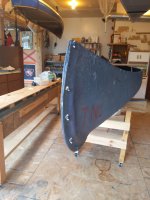Greetings all. I have been cruising over this forum for the last month or so, and felt that the time is drawing near (let's be honest, i plan to start in June) to start my first full build. Now, i canoe over very rocky areas and i have many kids, so the idea of a cedar strip canoe, while beautiful, does not appeal to me. I fear i would be in a constant state of cringing as my beloved boat got scraped and scratched over and over. I have been involved in a couple cedar strip builds already, and have made 2 sets of forms for others to build. Being a hobby woodworker and a career carpenter i feel quite comfortable with the strip canoe method. But, i want to build a composite canoe, and i have several big questions, so hopefully i can glean some help from this group....
Now let it be know that this is in the planning phase. I am ready to be called a fool, and be made aware of my follies.
I have available to me both the prospector 16 forms and a set of freedom 17 forms. I could make a different set, but these are 2 canoes that i like. I am leaning towards the prospector. I already own a nova craft Tripper, and while stable, i would like a bit more rocker. Also, the freedom with the low bow and stern looks a little... bland in my opinion.
My plan is to create a strip canoe out of pine (as i said, i have already done 2 cedar strips, but just only involved for the stripping part), and use it as a form. I would sand smooth, skim with body filler, sand, coat with mold paint, sand, fill, polish, done... I looked through some of the other posts here, and people tend to use the outside of the boats as a form. Why is that? When looking at how some of the professional companies do it they use the inside of the boat. This is one major question i had. Also, if i create a prospector where there is a bit of a... round over at the very top, how to get out of the form? Do i leave an end of my form just screwed together and open it up? Can it flex and squeeze enough to get it out? Or do i leave the ends of the canoe unfinished and finish it separately later?
I have done a very tiny bit of vacuum forming, and have been obsessively watching the "easy composites" youtube videos, and want to do a vacuum formed infused epoxy build. I think it called a dry layup. If i do a layer of innegra basalt as outer layer, then divinicell football and ribs, then some other layer (kevlar or fiberglass or open to suggestions here) then on the inside another layer of innegra basalt is that enough? Will canoe be sturdy wih 3 layers or do i need more?
oh, and remember when i said i had many kids... the reason i want to do this and do it with a form and such is that i would like to build at least 3 canoes.
I think that is all i have for now... please help me, you are my only hope.
Now let it be know that this is in the planning phase. I am ready to be called a fool, and be made aware of my follies.
I have available to me both the prospector 16 forms and a set of freedom 17 forms. I could make a different set, but these are 2 canoes that i like. I am leaning towards the prospector. I already own a nova craft Tripper, and while stable, i would like a bit more rocker. Also, the freedom with the low bow and stern looks a little... bland in my opinion.
My plan is to create a strip canoe out of pine (as i said, i have already done 2 cedar strips, but just only involved for the stripping part), and use it as a form. I would sand smooth, skim with body filler, sand, coat with mold paint, sand, fill, polish, done... I looked through some of the other posts here, and people tend to use the outside of the boats as a form. Why is that? When looking at how some of the professional companies do it they use the inside of the boat. This is one major question i had. Also, if i create a prospector where there is a bit of a... round over at the very top, how to get out of the form? Do i leave an end of my form just screwed together and open it up? Can it flex and squeeze enough to get it out? Or do i leave the ends of the canoe unfinished and finish it separately later?
I have done a very tiny bit of vacuum forming, and have been obsessively watching the "easy composites" youtube videos, and want to do a vacuum formed infused epoxy build. I think it called a dry layup. If i do a layer of innegra basalt as outer layer, then divinicell football and ribs, then some other layer (kevlar or fiberglass or open to suggestions here) then on the inside another layer of innegra basalt is that enough? Will canoe be sturdy wih 3 layers or do i need more?
oh, and remember when i said i had many kids... the reason i want to do this and do it with a form and such is that i would like to build at least 3 canoes.
I think that is all i have for now... please help me, you are my only hope.


